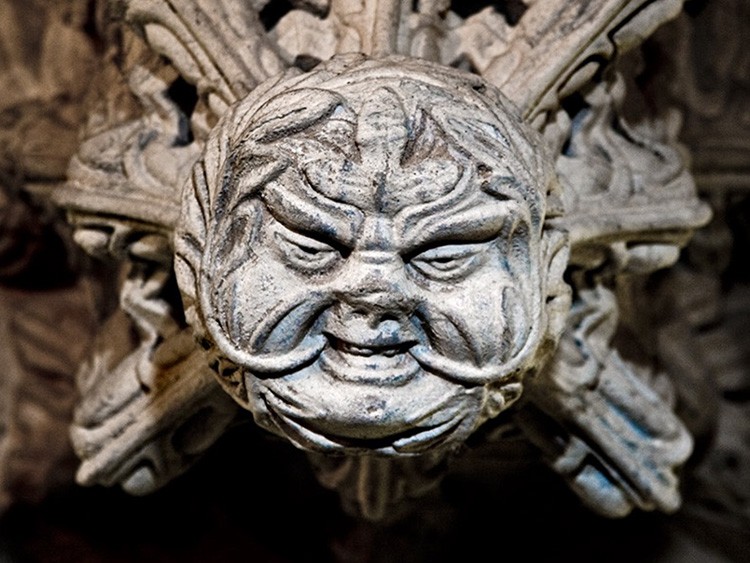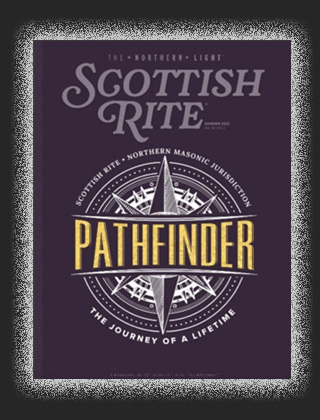
Tonight’s address is concerning the “Green Man” and “his” relationship to Freemasonry, Christianity, and paganism. Over the years, the “Green Man” and other stone carvings called foliage masks have been seen all over Europe on many buildings. Churches and public buildings of all sorts bear the visage of this icon in many forms. The most common is a man’s face with foliage, or vines and leaves growing out of the face. Thanks, in part, to Dan Brown and his books creating a relationship between freemasonry and Christianity via the eternal hunt for the Holy Grail, one particular chapel in Scotland has been a focal point for all three groups.
Rosslyn Chapel, located north of Edinburgh in Scotland, was commenced in approximately 1446 by William Sinclair, who was reputed to have been a Knight Templar that was likely engaged in warfare in the Holy Land. While neither of those facts has been confirmed, the chapel he constructed is filled with images of stone that when viewed as a whole, leaves the distinct impression that the site is religious. However, it is definitely not a Christian site and does not easily fit into any current well-known religious motifs. It is, in a word, unique revealing evidence that the architect was very much involved with initiatory mysteries.
One of the stone images carved into the interior of the chapel symbolizes a Green Man, which in certain religious studies has been associated with so-called pagan religions. After carefully studying those images, it appears more likely that the Green Man is consistent with a more Masonic interpretation of the Deity than of any other religion or philosophy.
Others have made the connection before Dan Brown, and have lead many to wonder if this icon is related to all three groups. In his article Secrets of the Freemasons , John Heisner states that academics around the globe are presently engaged in a concerted effort to identify the historical beginnings of Freemasonry. They do so by pursuing several avenues that promise empirical certainty once fully analyzed. However, since Freemasonry includes a diverse quantity of disciplines, it is not at all likely that the true origins will ever be discovered without a thorough evaluation of the symbolism Masonry has selected throughout the ages to impart wise and serious truths. Whether or not we will ever know the complete truth about Freemasonry's origin, one may begin the effort by pulling that veil aside and studying the diverse symbols of the Craft, as well as the various works of art created from the depths of man's soul and spirit.
While the figure certainly could symbolize the never-ending cycle of seasons and regeneration commonly found in other clearly defined pagan symbols, its origin is Greek and Roman. To them, the Green Man represented the full flowering of education and thus was inspirational to those contemplating the pursuit of knowledge. No doubt, as Euclid put together his volumes in the place where he worked, a smiling Green Man looked down upon him and his tomes.
The Green Man later found his way into Christian symbolism where he represented the immortality of the spirit and the resurrection of Jesus. Regardless of whether the Green Man represents Jesus linking Heaven to Earth, or the more simplistic pursuit of knowledge, it is undeniably the case that he also represents the growth of man's spirit.
A Secret of the Freemasons is that an affinity to the pursuit of knowledge has never been solely because it benefits he who learns, but because it eventually benefits those with whom he who learns comes into contact. Masonic writers who have explored both the science and philosophy of alchemy have also provided us with insight into how the Green Man represents the benefit of one man's knowledge to another man's welfare. Freemasonry has consistently adopted the belief that the Supreme Architect of the Universe manifests Himself through human growth - the urge moving from within a human being to a manifestation of action. There is no greater miracle than that produced by the tiny mustard seed, which when planted in the Earth produces a bush many thousand times its own size. The Holy Bible contains a parable that uses the tiny mustard seed to illustrate an important spiritual truth about the strength of faith. In Freemasonry, the Craft teaches that the Supreme Architect manifests Himself through an infinity of forms which is implanted into the dark material earth. One of those forms is art, which Masons are taught to both understand and create.
So, the relationship between Christianity, paganism, and Freemasonry continues to come back to referencing the Rosalyn Chapel. It was featured in several books, movies, as well as Christian and freemason publications.
In his article in the Masonic publication California Freemason Magazine 2005 edition, titled The Mysteries and Symbolism of Roslyn Chapel, Robert Cooper says that the Rosslyn Chapel was typical of a secular collegiate church of the time, and its style, decoration, meaning, and purpose were representative of the religious mores of the era. However, many recent publications claim that the chapel's carvings relate to the Knights Templar and have some mystical significance or are in some way Masonic. These suggestions appear to be based on ignorance of Christian art and symbolism, Scottish Masonic history and practice, and fanciful reinterpretations of the meaning of the chapel's carvings. At one time, everyone visiting the chapel would have immediately understood the meaning of the symbolism enshrined in stone. Because few people today fully understand this religious symbolism, this has allowed many incorrect explanations to be offered.
In addition, the understanding of the carvings has been hampered by ignorance of the sources from which the symbolism was originally taken. An example is the figure of a man with two horns holding a tablet in one hand and a rod in the other, which, it is claimed, depicts the devil tallying the number of souls he has ensnared. However, the Rev. John Thompson points out that the image is actually that of Moses with the tablets of the Ten Commandments.
Since 1560, many Scots have used Protestant Bibles that do not refer to Moses with horns, and it is therefore understandable that the carving has been misinterpreted. However, when the chapel was being built, the Bible in use was the Latin Vulgate, which describes Moses as having horns. In light of this information, the intention of the carved figure becomes obvious. But because fewer people than ever before are familiar with the Bible-let alone the differences between the numerous versions-it is easy to understand how secular interpretations of the symbolism in Rosslyn Chapel have become popular.
A further complication arises with the interpretation of symbols such as the so-called "green men," stone carvings that appear not only in Rosslyn, but in countless other churches throughout Britain. By claiming that Rosslyn Chapel is not really a Christian edifice, some have argued that the green man is actually a non-Christian image and is proof that the building has pagan origins. This is a fundamental misunderstanding of church history and its use of symbols. The green man was certainly a pagan symbol with several meanings: the never-ending pattern of the seasons, together with pre-Christian concepts of reproduction, fertility, and the agricultural cycle. The origins of the green man do not, however, lie with Britain's pre-Christian forbears but rather in classical antiquity. To the Greeks and Romans it suggested the full flowering of education and was therefore an inspirational symbol. When the green man was incorporated into Christian iconography it was assigned different attributes, creating several layers of meaning related to Christianity. The pagan interpretation of the green man was modified by Christians to represent the immortality of the soul and the resurrection of Jesus Christ. The symbol also demonstrated all of God's creation: animal (represented by the human face), vegetable (the foliage), and mineral (the stone from which the symbol was carved). There are several other Christian interpretations, but perhaps the most important is also simplest: The green man is Jesus Christ, who was sent by God from Heaven into the world, represented by the foliage. The symbol, therefore, shows that Heaven and Earth are linked through one person only-Jesus Christ.
In conclusion, the green man is basically an example of the ultimate cultural appropriation. It was originally an art form started by the Greeks to symbolize the growth and knowledge of man and our connection to nature. Over the years as it has been seen in many places, the pagans have appropriated it to represent the god aspect of the god and goddess, the Christians appropriated it as a sign of death rebirth and everlasting life, and thanks to the chapel, speculation about it being a Masonic symbol has brought it to us. From the humble beginnings as a simple piece of art, the symbol now joins us together in many ways: as Christians, pagans, and ultimately as Masons.
Shawn Housler, WM (Porter Lodge #137, 2023)
A presentation given on December 27th, 2022, at the Feast of St John, at Porter Lodge #137 in Valparaiso, IN



